by Winding Pathways | Jul 11, 2024 | Nature, Travel/Columns, Wonderment
Winding Pathways is near the edge of town, making it easy to drive into the country and enjoy rural views. Mostly our car traverses Iowa’s abundant corn and soybean fields, but two recent trips gave exceptional views of different vegetation that bloomed in bright lavender under the June sun.
The Lavender Farm
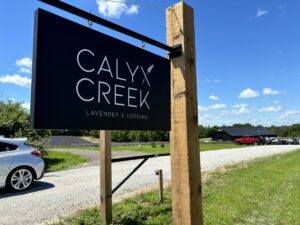
Entry to Calyx Creek
One recent June afternoon as we drove through conventional crops an amazing and delightful view appeared. Shades of purple and stunning white blanketed the undulating land accenting the deep green of cultivated crops. We had discovered Calyx Creek Lavender and Lodging a few miles west of North Liberty, Iowa. Rows of lavender in various stages of growth surrounded us as we entered the main building to find various products made of this unusual plant.
The warm, calming fragrance of the oils of this subtle herb wafted through the shop. Dried bunches hung from racks. Informational signs in front of gleaming machines shared highlights of the distillation process. Soaps, oils, candles, carpet freshener, lavender-infused stuffies and slippers, beverages, and tasty treats beckoned visitors to sample and buy. A lemonade mix was a hit among patrons on this warm summer day. “It smells so good inside, and this lemonade is super!” commented one man, cupping the cool drink in his hands.
-

-
An array of products awaits.
-

-
Slushys are popular.
Tours and Lodging
Part of the experience includes tours, opportunities to harvest and enjoy in your own home, and overnight lodging!
We walked among fields of blooming lavender to two of the several cabins available for rent. The two, built on pedestals, are well-equipped. All the lodgings offer a chance to “get away” while being close to nature. We climbed the stairs, sat on the small cabin’s deck, and took in the rural views of expansive fields of lavender. Peace flowed through us.
-

-
Strolling through lavender fields
-
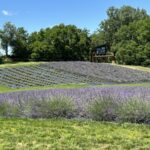
-
Peaceful overnights
Calyx Creek Lavender and Lodging is a fun place to visit, especially during the early summer blooming time. More information at: Calyx Creek LLC, 1722 255th St. NW, Oxford, IA 52322.
Phone: (319) 900-5992
Where Does Lavender Originate?
Lavender is native to the Mediterranean Region of southern Europe and Northern Africa. It has so many uses that it has been planted around the world. It has become problematic in Australia but is a valued product in North America. Lavender has a long, documented, and storied history with applications for improved health, reducing anxiety, moderating the effects of bug bites and burns, and as an antiseptic/anti-inflammatory agent. The latter is useful in the flu season. Gardeners can grow lavender at home. A helpful resource on how to grow it is at Garden Design.
More Rural Views
The fields of lavender at Calyx Creek are carefully groomed, providing a contrast to our discovery the next day. Secondary roads stairstep through Iowa, replete with rural views of corn, beans, oats, cattle, and goats. We were making our way to a reconstructed prairie south of Waterloo, Iowa
The Irvine Prairie
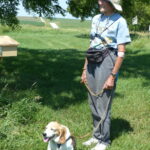
A happy duo.
That day Cathy Irvine led us through her prairie dotted with pale purple coneflowers, purple prairie clover, and blooms of different hues. Common yellowthroats serenaded us as red-winged blackbirds winged around this amazing place.
We admired the beauty of one of Iowa’s largest reconstructed prairies and were humbled to have Cathy Irvine share part of her day with us. Some people are so inspiring. She’s one.
After years of conventional farming, her vision took her land in a different direction. She’d turn the clock back and restore her land to how it looked and functioned before the first plow turned the original prairie into row crops. She didn’t do this on a whim. For decades Cathy had thought about, researched, attended programs on, and connected with experts on prairies. She knew that reconstructing the native habitat with its diverse plants and animals was right to do.
-
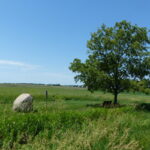
-
Glacial boulders are part of the landscape.
-

-
Contrast
Collaboration
Working with the Iowa Natural Heritage Foundation and the University of Northern Iowa Tallgrass Prairie Center she placed much of her farm in conservation easement and collaborated on restoring it to its native vegetation in honor of her late husband, David. Being in a conservation easement means that it will remain a wild and gorgeous prairie forever, no matter who might own the land in the future.
Iowa’s Rich Heritage
Iowa’s original prairie hosted upwards of 300 plant species on each acre that agriculture transformed into vast monocultures of soybeans and corn. Cathy’s land was in row crops until she decided to give her property to the Tallgrass Prairie Center under a conservation easement. Starting in 2018 the Prairie Center began planting upwards of 100 native species an acre and followed it up with prescribed burning, weeding, and even plugging in more native species.
Cathy, the Tallgrass Prairie Center, and the Iowa Natural Heritage Foundation welcome visitors to experience what much of Iowa once looked like. It’s a place to enjoy dancing prairie grasses and forbs on a breezy summer day, listen to birds trilling across the expanse, watch butterflies forage on blooms, and be inspired by the quiet beauty resulting from a transformation springing from Cathy’s vision and cooperative effort.
The Prairie is located at 1173 55th Street, Dysart, Iowa. Several mowed trails radiate outward from a small parking lot. A bench nestled under a spreading tree offers shade and a place to reflect.
-
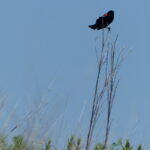
-
Calling out territory
-

-
colorful forbs
-
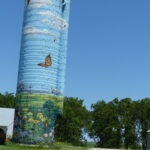
-
Colorful silo
Best Times To Enjoy Prairie Flowers
Prairie flowers bloom throughout the growing season but during midsummer’s heat, the colors are most amazing. However, the prairie is magical in any season. We enjoy our small reconstructed prairies through all seasons and especially in the summer months.
The Lavender Farm meticulously cultivates a useful plant not native to Iowa and the Irvine Prairie carefully stewards a rewilded prairie. Both are gorgeous.
For more information, visit the Tallgrass Prairie Center and the Iowa Natural Heritage Foundation websites.
The Color Purple
Our eyes had the good fortune to view purple lavender one day and purple prairie flowers the next, but purple is a tricky color, at least for some people. Like around 10% of men and boys, Rich isn’t able to see it or see it as folks with normal color vision can. “Red and shades of red are hard for me to see. Purple is nearly impossible. It seems odd but I can see the color but know it looks very different to me than to most folks. If someone asks me what purple looks like I have to say, I’m not sure since I can’t really see it,” he said. “Fortunately I can see blue and yellow prairie blooms and magnificent butterfly milkweed flowers that seem to glow a bright orange,” he added.
Winding Pathways encourages readers to take in any of their native habitat to appreciate our green island home – Earth.
by Marion Patterson | Mar 7, 2024 | Reflections/Profiles, Wonderment
Dupuytren’s Contracture: The Curse of the Vikings! Usually, we blog about nature and yards at Winding Pathways, but once in a while, we digress. This one’s about Rich’s Dupuytren’s adventure. But it is related to nature, as putting on gloves and manipulating his hand was becoming more difficult as two of his fingers began to curl. Also, genetics is nature.
Dupuytren’s Contracture is fairly common. It runs in families. The fingers on Rich’s Dad, Henry Patterson, curled so severely that manipulating tools, knobs, buttons, and eating utensils became difficult despite two surgeries to correct the condition.
Curse of the Vikings
So, what is it? Dupuytren’s Contracture was named for a French surgeon who described it first. It’s most common in men with Northern European ancestry, especially from Scandinavia and Scotland. That fits. Rich’s ancestors were from Denmark and Germany.
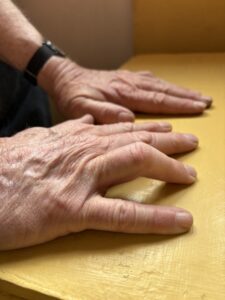
It’s caused when a knot of fascia forms under the skin usually in the palms beneath the ring finger and pinky. Sometimes a hard cord of material grows up the finger, forcing it to curl downward. Eventually, the finger can curl to about 90 degrees from the palm.
Women can get the condition, but less frequently than men, and often it’s not as severe.
Watchful
Rich first noticed a knot in his palm when he was 55 years old and gradually two of his fingers began to curl, making it impossible for them to lay flat on a table. There’s no way to predict whether Dupuytren’s will continue to grow or ever become a problem.
For many years Rich’s hand functioned normally with a slightly curved ring finger.
Doing Something About This
About two years ago he visited Dr. Clifford Novak, a hand surgeon at Cedar Rapids’ Physicians Clinic of Iowa. He encouraged Rich to return if the condition worsened or interfered with everyday activities. It started to, so in mid-2023 he again visited Dr. Novak and learned of three possible treatments: surgery to remove the material, needle aponeurotomy to cut the long cord causing the curl, and chemical treatment.
Because his condition was not profound and recovery sounded the easiest, he chose the needle method.
Surgery
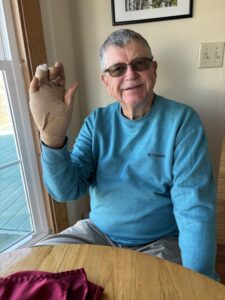
The hand was bandaged for four days.
On February 23, 2023, Dr. Novak performed the surgery. Rich stayed in the outpatient Surgery Center for just four hours. He left with his hand heavily bandaged, making typing and any other form of manipulation difficult….but for only four days. On February 27th a physical therapist removed the bandages and gave Rich a series of exercises to help straighten the finger. Amazingly there were no sores or scars where the needles were inserted. For the first time in several years, he could lay all his fingers flat on a table. There was no pain. The result is amazing.
Follow-Up
There’s no assurance the Dupuytren won’t grow back in the same finger or progress in other fingers, but the surgery was so successful it could be repeated if needed.
Dr. Novak’s advice was to treat the curled finger BEFORE it became difficult to use.
Rich did this with success as these after photos reveal.
-
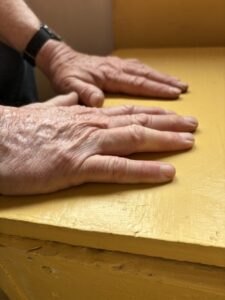
-
Improved straightened finger.
-
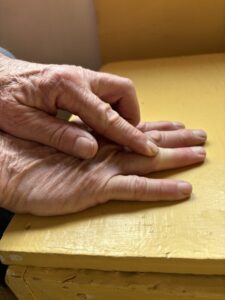
-
Exercises are simple and critical to recovering use of the finger.
by Winding Pathways | Jan 11, 2024 | Travel/Columns, Wonderment
What did I do yesterday morning? Did I make it to that meeting last Monday? Darn. I can’t remember. I’m forgetful. Fortunately, my journal writing isn’t.
18,250 days
Every day since April 1973 I’ve written a simple journal entry on small format lined binder paper. Haven’t missed a single day. Entries aren’t great writing and are rarely emotional. It’s not a diary. On some days I write only a few lines, while I might fill a page on more happening days.
My journal records about 18,250 days of my life. Combined notebooks take up about three feet of shelf space.
Uses of Journaling

Journals
Useful? Yup. When did we go to Yellowstone National Park? I remembered the month and year but not the dates. In minutes I found those dates in my notebook and learned what we did each day. What did we do on Christmas Eve 18 years ago? My journal reminds me.
My notes are simple, short, and often skip perfect grammar, but they are meant to bring every day into clear memory………so each journal entry records something distinctive about that day. Here’s a simple entry:
Monday, January 16, 2023: Weirdly warm with temperature in the 50s. Made new plywood shelves for my tool cabinet. Payton (a neighbor kid) was visiting when sirens blew warning of a potential tornado. We sheltered in the basement. No tornado here but one hit near Williamsburg, the first January tornado in Iowa since 1967.
Like Brushing Teeth
I’ve been journaling for so long it is as routine as brushing my teeth. Blank journal paper goes with me on trips, and I’ve even scribbled entries by lantern light at campgrounds.
My memory lapses. My journal never does.
What are Ways YOU Remember?
People have other ways to remember or “journal.” Share some and we can post on Winding Pathways
by Winding Pathways | Oct 19, 2023 | Nature, Wonderment
Tattoos to You
Recently we have noted people’s tattoos. How fun and meaningful they are. That has not always been the case. Throughout cultures, in eras past, tattoos have been both shunned and venerated. Dating from 5,000 years ago, in Japanese cultures, tatts identified gangs and slaves. Similar to today in different regions of the world.
On the other hand, ancient Egyptian themes centered on fertility and protection in childbirth, the arts and dance.
European Influence
The Picts and Celts of Scotland and Ireland sported fierce body art that duly impressed the Roman soldiers who admired the virile images and feared the fierce warriors.
Europe’s relation with tattoos has been influenced by the several other cultures that invaded over centuries. Again, its fortunes rose and fell as cultures adopted for signs of wealth or as ways to identify slaves. The sordid history of tattoos associated with Nazis soured Americans on tattoos until more recent years. Today, people of all ages and social statuses sport tattoos. Most have special meaning to the person displaying them.
Here are a few we’ve chatted with people about.
-

-
Each a story
-
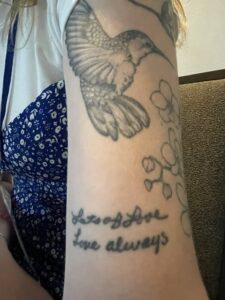
-
Loving sentiment
-
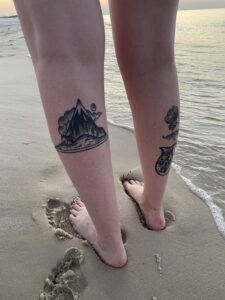
-
Mountains and Vases
Kate started the quest for stories at the recent Outdoor Writers Association of America conference at Gulf Shores, Alabama. When she travels she researches tattoo artists in the cities and countries she plans to visit, scans their electronic portfolios, checks their credentials, and connects with them. From standard to fine lines, and from nature to sayings by loved ones, each tells stories important to her and is a memento of trips.
-
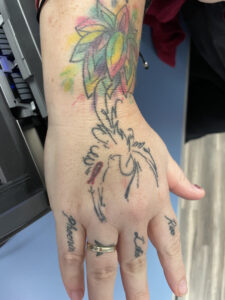
-
Rising
-
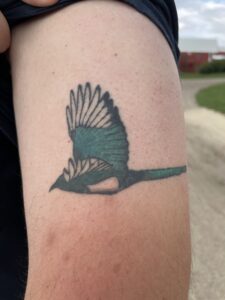
-
Taking flight
Nature themes are popular. The phoenix theme rising again and a nod to the tattoo owner’s children and the magpie is often interpreted as a sign of good luck.
-
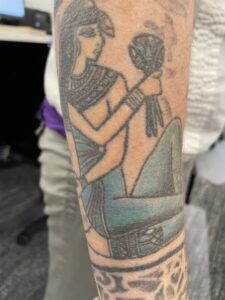
-
Fertility and parenting
-
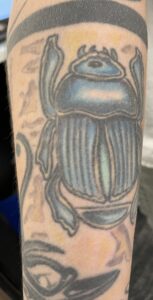
-

-
Mermaid with tattoo.
Egyptian themes have resonated with librarians and “mermaids!” Harthor, the Goddess of fertility, love, and protection in birth & parenting; the “good luck” scarab beetle; and cats, are always venerated in Egyptian mythology.
-
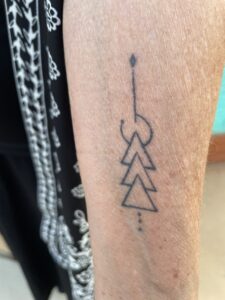
-
All ages enjoy tattoos
-
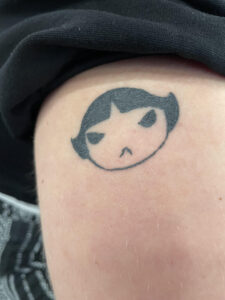
-
Power Puffs have super powers.
-
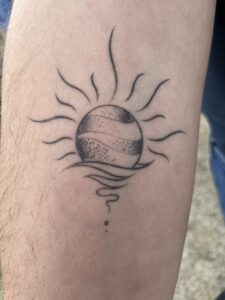
-
This tattoos honors siblings and travel.
-
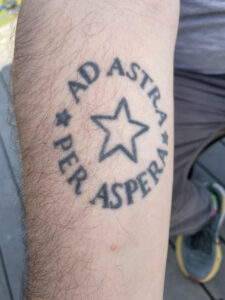
-
Kansas motto tattoo.
Triangles connect family, Buttercup, of the Powerpuff Girls, the animated TV series from the 1990s inspires humor and superpowers. The State of Kansas motto shines brightly on this man’s arm.
Sailors popularized tattoos in the 1700s when returning from long voyages, especially from the Pacific Islands, sporting elaborate tatts. Of course, soon, royalty had to follow. Purportedly even Winston Churchill and his mother had tattoos.
The popularity of tattoos is on the rise with personalized images and sayings in full display.
by Winding Pathways | Aug 3, 2023 | Garden/Yard, Nature, Wonderment
At the foot of East Post Road SE, just by Indian Creek is the frog statue that dons varied outfits each season and for many events. Take a look through the years. And visit our website for amphibian blogs.
The frog is serious about keeping healthy and helping after storms.
-
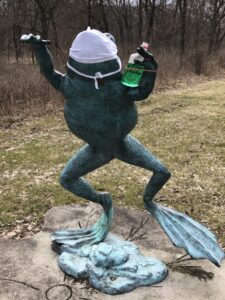
-
Masks and hand sanitizers did their jobs to help reduce the spread of SARS-CoV-2
-
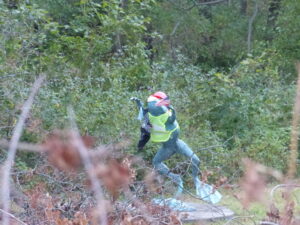
-
Cleaning up after the 2020 Derecho.
Further into the year:
-
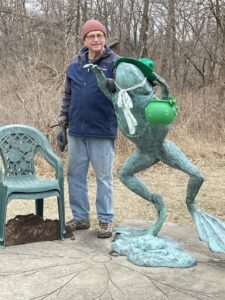
-
A green pot of gold.
-
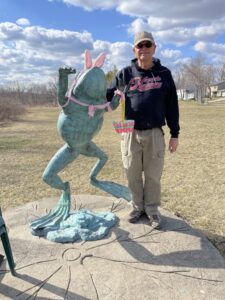
-
Hoppy Easter!
-
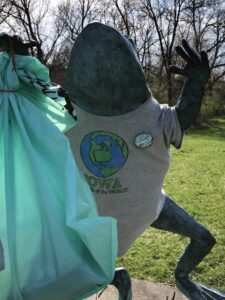
-
Keeping it Clean
Middle of the Year is graduation, summer fun, and the Fourth of July with a loyal “Vandal” from Idaho!
-
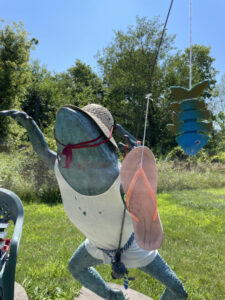
-
Summertime and the livin’ is easy.
-
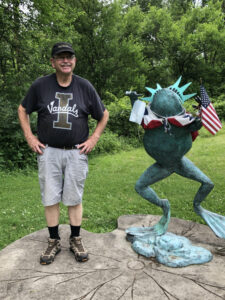
-
Frog And Vandal (UIdaho) posing.
-
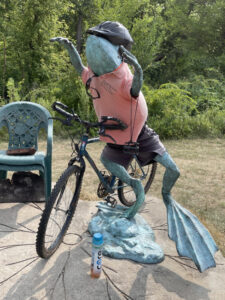
-
Amphibian Safety Patrol…
-
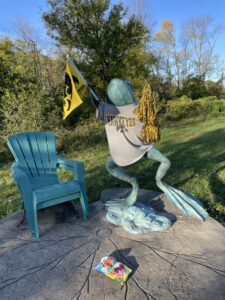
-
Go Hawks!
-
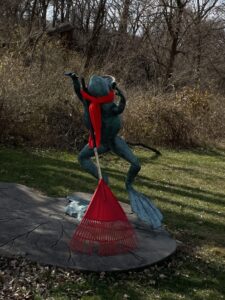
-
Does this frog practice Reiki?
-
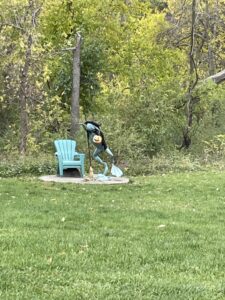
-
Coming for the candy.
Always a civic Duty Calls.
-
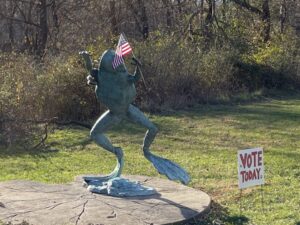
-
Research first.
We are “hopping” to add more photos as we walk by the ever-current and exciting Frog Statue. To learn about real frogs of Iowa visit the website link.
by Winding Pathways | Jun 29, 2023 | Gazette Features, Travel/Columns, Wonderment
HOW?
Ancient people accomplished what seems impossible. How did they do it?
We recently toured the Earthmoving Legacy Center near Elkader, Iowa. On display were diesel and gasoline-powered machines able to move massive quantities of dirt for today’s needs. (Moving Heaven and Earth)
A month later we stood in a field near Chillicothe, Ohio, gazing at an enormous earth mound. The next day we visited other nearby sites with earthen walls, circles, and squares. All were separated by many miles and were large – some spanning hundreds of feet long and dozens of stories high. All were made around 2000 years ago by people of the Hopewell Culture. We learned that the squares are identical and fit inside the large circles. Somehow, they did this hard work without machines. No metal shovels. Not even wheelbarrows. How did they do it?
-
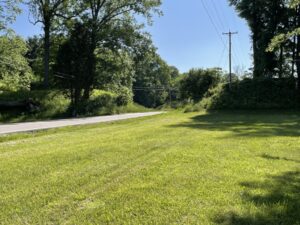
-
Modern intersecting with ancient.
-
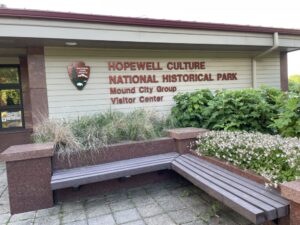
-
Headquarters.
Can a Principle of Geology Lend Insights?
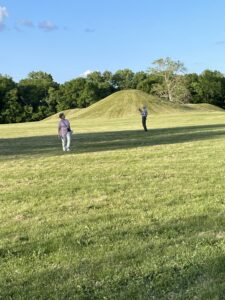
Recreated Earthworks
Hopewell, like visits to Effigy Mounds National Monument in Iowa and Cahokia in Illinois, stimulates more questions than answers. Perhaps a tenet of Geology can guide us. The Present is the Key to the Past. So, let’s consider. Why do we build structures? How do we move earth today? What do people who build need to sustain them while they build? (Food, shelter, clothing) Who provides this? Where do we get our goods? Perhaps these questions can provide insight into the past.
History is Written by the “Victors”
In our 1950s and 1960s school classes, we learned that European explorers and early settlers discovered scattered bands of Native Americans making a primitive living hunting, gathering, and gardening. No mention was made of our continent’s once vast population of sophisticated, technologically-advanced, and organized Native Americans who built magnificent structures and had an extensive trade system. Some of us did learn about the impressive Mayan and Aztec cultures in Mesoamerica.
Amazing Commerce
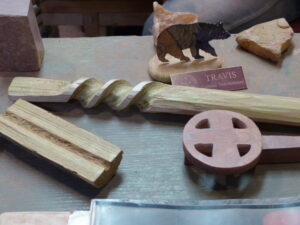
Pipestone was traded far and wide.
Little did we learn about the varied North American indigenous cultures that were far superior than originally believed. For example, Hopewell people made tools of obsidian that originated at Yellowstone, created jewelry of copper from the upper Great Lakes region, and used shells from the Gulf of Mexico. They somehow got these distantly sourced goods without airplanes, trucks, or Amazon Prime! Somehow goods moved across thousands of miles before horses and even wheels were available.
Sources of Information
Archeologists have solved some riddles about how ancient people did things, but many mysteries remain. Puzzling and fascinating. We have had published a number of pieces on ancients including the desert Southwest, to Pipestone in Minnesota, to Mounds along the Mississippi from Effigy to Cahokia.
Together, let us learn more about the rich heritage that is both before, beneath us, and behind us. A good source of information is The Great Courses offerings by Dr. Edwin Barnhart, Ancient Civilizations of North America, and Dr. Daniel Cobb, Native Peoples of North America.












































